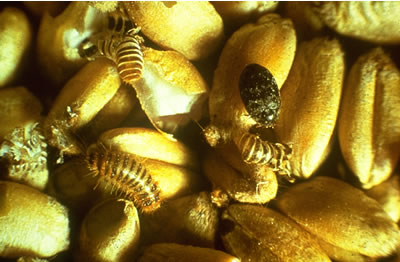Insects - wheat
Contributors to this page: CIMMYT, Mexico (Etienne Duveiller, Monica Mezzalama, Eloise Phipps, Thomas Payne, Jesper Norgaard), Independent consultant (Jesse Dubin).
Khapra beetle
|
Adult, larva, larval skins of T. granarium |
Scientific name
Trogoderma granarium Everts
Importance
High phytosanitary importance.
Significance
The khapra beetle is considered to be one of the world's most destructive pests of grain products and seeds. It is principally serious under hot dry conditions. Reproduction may be so rapid that larvae are found in large numbers in the surface layers of binned grain. The discovery of T. granarium in a non-infested area usually leads to an immediate quarantine of suspected goods and an expensive eradication and control effort.
Symptoms
Presence in stored grain. The stage most commonly seen during inspection is the larva, and the most usual evidence for infestation is cast larval skins.
Hosts
Grain and stored product hosts.
The beetle is by nature an omnivorous protein scavenger and has been found in many locations that would not be obvious food sources.
Geographic distribution
T. granarium probably originated in the region now including Bangladesh and India. It has since spread to other areas including northern and eastern Africa, southern Europe and the Mediterranean region, and the Middle East.
EPPO distribution map: http://www.eppo.org/QUARANTINE/insects.
Biology and transmission
T. granarium is a member of the Coleoptera family Dermestidae.
The eggs are milky white, turning pale yellowish with age, cylindrical, 0.7 by 0.25 mm, with one end rounded, the other pointed and bearing spine-like projections.
The larvae at hatching are approximately 1.6 to 1.8 mm long, more than half of this length consisting of a tail made up of hairs on the last abdominal segment. Larvae are uniformly yellowish white, except the head and body hairs, which are brown. As the larvae increase in size, their body color changes to a golden or reddish brown, more body hairs develop, and the tail becomes proportionally shorter. Mature larvae are approximately 6 mm long and 1.5 mm wide. Larval development may occur in four weeks, but under conditions of cooler temperatures, crowding, or poor food quality the larvae may enter diapause.
Adults are oval-shaped and brown to black in color, with indistinct lighter brown patterns on the elytra. The adult males are 1.4-2.3 mm long and 0.75-1.1 mm wide; adult females are 2.1-3.4 mm long and 1.7-1.9 mm wide. They appear densely hairy under a microscope. These hairs may trap dust, giving a dirty appearance. Adults are short-lived, persisting only for one to two weeks.
This beetle has never been observed to fly; therefore, its spread is probably dependent on movement of infested goods or in containers where it may be transported while in diapause.
Detection/indexing methods
- At CIMMYT: Physical inspection of seed.
- At ICARDA: Visual inspection
Treatment/control
- Fumigation using methyl bromide is the treatment of choice. Because of the khapra beetle's habit of hiding in cracks and crevices and infesting porous block, the entire storage structure, in addition to its contents, must be fumigated. The future for the continued use of methyl bromide fumigation for khapra beetle is currently uncertain.
Procedures followed at the centers in case of positive test
- At CIMMYT: The seed lot is destroyed (the pest is quarantined in Mexico).
- At ICARDA: Double dose of fumigation with phostoxin
EPPO protocols
EPPO Diagnostic Protocols for Regulated Pests PM 7/13(1): Trogoderma granarium. EPPO Bulletin 32: 241-243. [online] Available from URL: http://www.eppo.org/QUARANTINE/insects/. Date accessed 07 April 2010
References and further reading
Banks HJ. 1977. Distribution and establishment of Trogoderma granarium Everts (Coleoptera: Dermestidae); climatic and other influences. Journal of Stored Product Research 13: 183-202.
Buss LB, Fasulo TR. 2006. UF/IFAS Photo Gallery Stored Product Pests CD-ROM SW 185. Unifersity of Florida IFAS Extension.
EPPO. Data Sheets on Qurantine Pests: Trogoderma granarium. [online] Available from URL:http://www.eppo.org/QUARANTINE/insects/. Date accessed 07 April 2010
French S, Venette RC. 2005. Mini risk assessment: khapra beetle, Trogoderma granarium (Everts) [Coleoptera: Dermestidae]. United States Department of Agriculture. [online] Available from URL: http://www.aphis.usda.gov/ Date accessed 07 April 2010
Lowe S, Browne M, Boudjelas S, DePoorter M. 2000. 100 of the World's Worst Invasive Alien Species: A Selection from the Global Invasive Species Database. Invasive Species Specialist Group, World Conservation Union (IUCN). 12 pp. [online] Available from URL: http://www.issg.org/booklet.pdf. Date accessed 07 April 2010
Szito A. (2006). Trogoderma granarium (insect). Global Invasive Species Database. [online] Available from URL: http://www.issg.org/database/ Date accessed 07 April 2010.
Von Ellenrieder N. 2004. Pest Sheet: Khapra beetle (Trogoderma granarium). Entomology Laboratory, Plant Pest Diagnostics Center, California Department of Food and Agriculture. [online] Available from URL: http://www.cdfa.ca.gov/. Date accessed 07 April 2010
ZipcodeZoo.com. 2009. Trogoderma granarium (khapra beetle). [online] Available from URL: http://zipcodezoo.com/Animals. Date accessed 07 April 2010
Comments
- No comments found






Leave your comments
Post comment as a guest